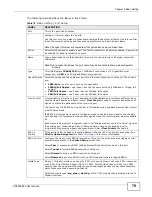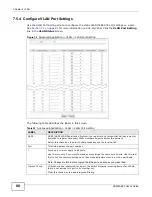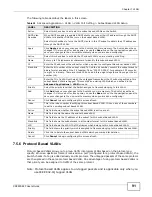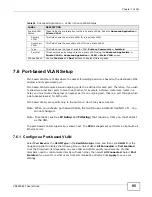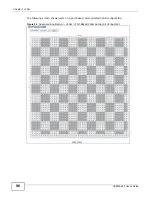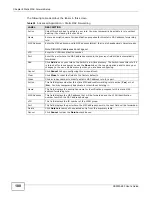
Chapter 7 VLAN
XS3900-48F User’s Guide
89
7.5.5 Subnet Based VLANs
Subnet based VLANs allow you to group traffic into logical VLANs based on the source IP subnet you
specify. When a frame is received on a port, the Switch checks if a tag is added already and the IP
subnet it came from. The untagged packets from the same IP subnet are then placed in the same
subnet based VLAN. One advantage of using subnet based VLANs is that priority can be assigned to
traffic from the same IP subnet.
Note: Subnet based VLAN applies to un-tagged packets and is applicable only when you
use IEEE 802.1Q tagged VLAN.
For example, an ISP (Internet Service Provider) may divide different types of services it provides to
customers into different IP subnets. Traffic for voice services is designated for IP subnet
172.16.1.0/24, video for 192.168.1.0/24 and data for 10.1.1.0/24. The Switch can then be
configured to group incoming traffic based on the source IP subnet of incoming frames.
You can then configure a subnet based VLAN with priority 6 and VID of 100 for traffic received from
IP subnet 172.16.1.0/24 (voice services). You can also have a subnet based VLAN with priority 5
and VID of 200 for traffic received from IP subnet 192.168.1.0/24 (video services). Lastly, you can
configure VLAN with priority 3 and VID of 300 for traffic received from IP subnet 10.1.1.0/24 (data
PVID
A PVID (Port VLAN ID) is a tag that adds to incoming untagged frames received on a port
so that the frames are forwarded to the VLAN group that the tag defines.
Enter a number between 1 and 4094 as the port VLAN ID.
GVRP
Select this check box to allow GVRP on this port.
Acceptable Frame
Type
Specify the type of frames allowed on a port. Choices are All, Tag Only and Untag Only.
Select All from the drop-down list box to accept all untagged or tagged frames on this
port. This is the default setting.
Select Tag Only to accept only tagged frames on this port. All untagged frames will be
dropped.
Select Untag Only to accept only untagged frames on this port. All tagged frames will be
dropped.
VLAN Trunking
Enable VLAN Trunking on ports connected to other switches or routers (but not ports
directly connected to end users) to allow frames belonging to unknown VLAN groups to
pass through the Switch.
Isolation
Select this to allows this port to communicate only with the CPU management port and
the ports on which the isolation feature is not enabled. This has a higher priority than
private vlan settings, so promiscuous ports configured in the Advanced Application >
Private VLAN screen will not be able to communicate with each other if Isolation is
selected here.
Apply
Click Apply to save your changes to the Switch’s run-time memory. The Switch loses
these changes if it is turned off or loses power, so use the Save link on the top navigation
panel to save your changes to the non-volatile memory when you are done configuring.
Cancel
Click Cancel to begin configuring this screen afresh.
Table 23
Advanced Application > VLAN > VLAN Port Setting (continued)
LABEL
DESCRIPTION
Summary of Contents for XS-3900-48F
Page 15: ...15 PART I User s Guide ...
Page 16: ...16 ...
Page 48: ...Chapter 2 Tutorials XS3900 48F User s Guide 48 ...
Page 62: ...Chapter 4 The Web Configurator XS3900 48F User s Guide 62 ...
Page 63: ...63 PART II Technical Reference ...
Page 64: ...64 ...
Page 227: ...Chapter 26 VLAN Mapping XS3900 48F User s Guide 227 ...
Page 320: ...Appendix A Common Services XS3900 48F User s Guide 320 ...
Page 332: ...Index XS3900 48F User s Guide 332 ...





